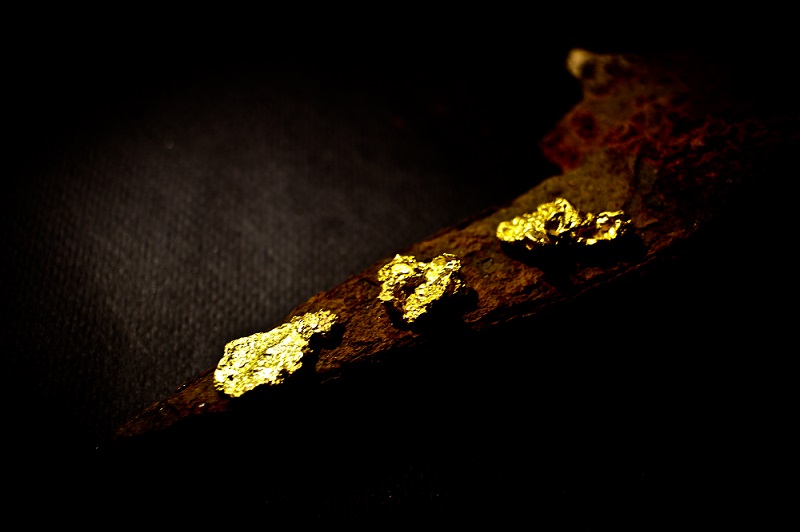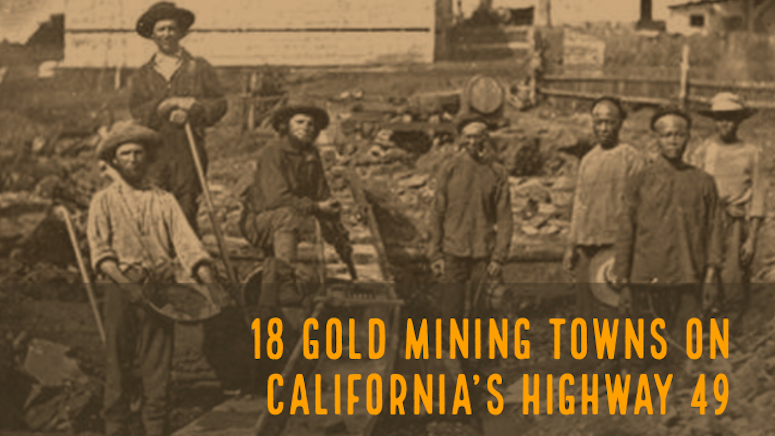
California was without a doubt the most famous gold rush in the entire world. And in California, there was no richer area than the western slopes of the Sierra Nevada. At current prices, there were literally trillions of dollars mined from this rich region of Northern California.
Today, some of the most historic and iconic mining town in California history can be accessed along Highway 49. Much of the highway follows the low foothills of the Sierras, and over the course of several hundred miles it passes through some of California richest mining towns.
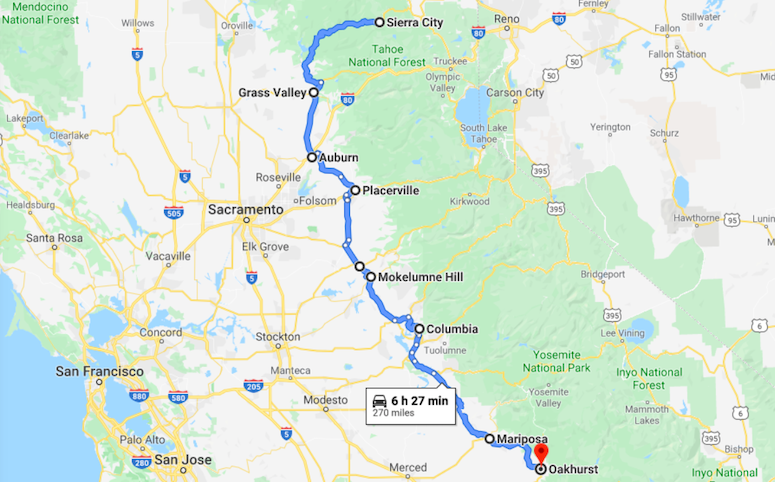
Let’s take a drive and look at some of the historic mining camps that now sit along the historic Highway 49. We start high in the northern Sierra Nevada Mountains, and wind our way down several hundred miles to the southern extent of the gold belt.
1. Sierra City
Starting in the high country, this was one of the first mining camps in California following the discovery of gold. Sierra City sits along the North Yuba River, and has been around since 1850. An avalanche destroyed the town in the first year, but it was eventually rebuilt and mining boomed. This is the site of many hard rock mines that sustained the town long after the placers were depleted. Sierra City also gets credit for the location of California largest gold nugget discovery. The Monumental Nugget was found in this area and weighed 106 troy pounds!
2. Downieville
As you head downstream on the North Yuba River you will come to Downieville. This area was so exceptionally rich that the first claims only allowed 30 feet per man, showing the exceptional richness of the gravels.
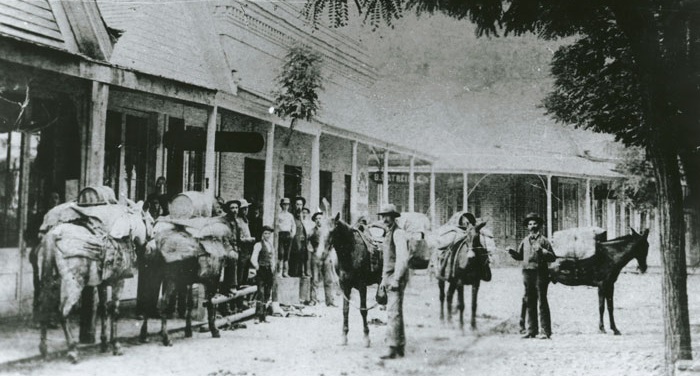
Miners in downtown Downieville load up with gear to bring back to their claims.
3. Nevada City
Nevada City has certainly done a good job of capturing the essence of an early mining town. It is one of the better preserved gold rush towns in the region. As such, it is a popular town for tourism.
4. Grass Valley
Just a few miles south of Nevada City is the larger town of Grass Valley. This was one of the richest camps in the area, with extensive mining in the surrounding mountains. The largest mine was the Idaho-Maryland Mine. It produced exceptionally rich ores, and was so extensive that it operated on and off for nearly 80 years. When visiting you can take in some great mining history at the Northstar Mining Museum and the Empire Mine State Park.
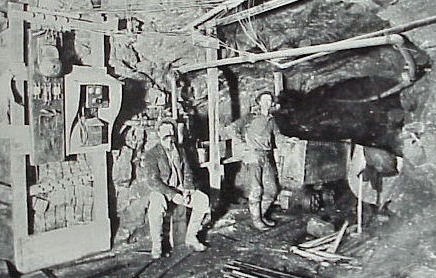
Miners underground at the Empire Mine.
5. Auburn
Yet another rich mining camp during the early days of the gold rush, the early miners here were focused on the rich placer gravels in the North Fork American River. This area sees a lot of activity because it is so easily accessible from Sacramento. The Auburn State Recreation Area is a great place for casual prospectors to do a little gold panning. There is also a great Gold Rush Museum in town.
6. Coloma
This is perhaps the most famous town along Highway 49 because this was the site of the first gold discovery by James Marshall at Sutter’s Mill. It sits along the South Fork American River. Obviously there is plenty for visitors to see and some great family friendly activities relating the the Gold Rush. Several state parks provide panning opportunities.
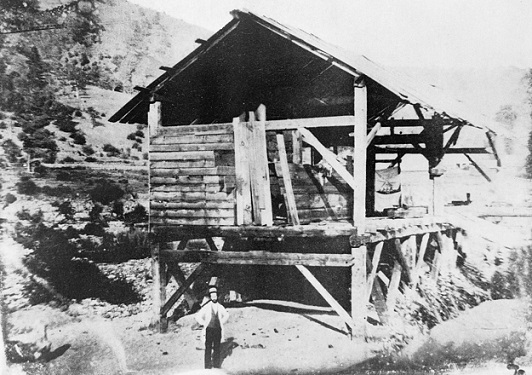
Sutter’s Mill at Coloma, the location that started it all!
7. Placerville
Another famous gold camp along the South Fork American River, the early miners worked the ancient river channels above the river and recovered some amazing gold. You should definitely check out the Gold Bug Mine, which dates back to 1888. You can go underground and see the old underground workings, a blacksmith shop and an old stamp mill.
8. Amador City
There was extensive gold mining activity around Amador City, which sits just off of Highway 49 to the east. The first mining took place on the unnamed creeks above the current town site, but it was the Keystone Mine that put Amador City on the map. There are lots of historic old buildings in town as well, so its definitely worth taking the detour off the highway!
9. Jackson
One of the best mine tours in California is at the Kennedy Mine in Jackson. It is one of the deepest mines in the US (5,912’) and offers guided tours of the surface structures. The history here is extensive and a must-see for true history “bugs.” Tour guides will explain the mining process and history of this amazing old mine.
Read: 6 Underground Mine Tours in California
10. Mokelumne Hill
Mokelumne Hill was one of the richest sites in California. Some of the ground was so rich that the claims were limited to 16 square feet per man! At one time it boasted a population over 15,000 which was quite high for the time. The townsite still has some nicely preserved historic buildings. There is good gold all up and down the Mokelumne River. The notorious bandit Joaquin Murrieta was known to spend some time here.
11. San Andreas
The townsite is located near the confluence of the North Fork and South Fork Calaveras River. Early miners found rich placers in the river and mined it extensively starting in 1848. The town became well-known for very large gold nuggets. Some of the richest gold deposits were mined from an ancient river channel that sits above the town.
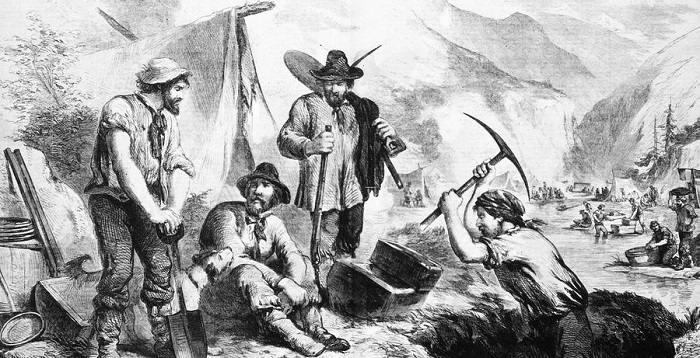
12. Angel’s Camp
Miners found decent gold among the gravels of Angel’s Creek and of course nearby Stanislaus River which attracted attention to the areas. As the paying placers started to dwindle, more attention was focused on the quartz vein stringers in the hills around town. The Utica Mine was the big producer at Angel’s Camp. Stamps operated ‘round the clock to break up ores and extract the free-milling gold.

13. Columbia
This is one of the picturesque mining towns along Highway 49, with a nice variety of historic building, structures and old mining relics to see. Early miners had trouble working the rich bench deposits because water was lacking, so a 60-mile ditch was constructed from the Stanislaus River to wash gravels. What resulted was a rich gold camp for many years to come. Check out the Columbia State Historic Park to see some of the early relics dating back to the earliest days of the Gold Rush.
Also Read: The Age of Gold: The California Gold Rush and the New American Dream
And: The California Gold Country: Highway 49 Revisited
14. Sonora
This town first got its name from the high population of miners from Sonora, Mexico. The first miners mined the gravels of Woods Creek, but soon realized that all of the smaller creeks and gulleys around Sonora had gold. Ditches were dug and hydraulic mines were established to further process the gravel. Sonora became known as the “Queen of the Southern Mines,” as it was one of the richer locations at the southern end of the Sierras.
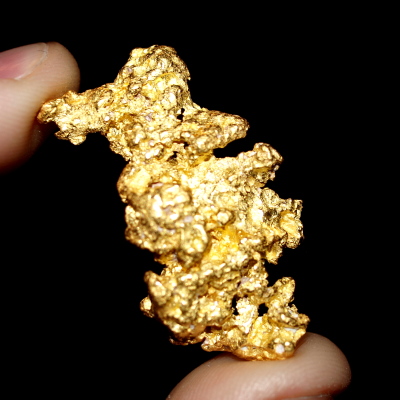
15. Jamestown
Woods Creek flows right through Jamestown, and this was where the early ‘49ers found some exceptionally rich gold deposits. Dust, flakes, and chunky nuggets filled their sluice boxes for many years following the first discoveries. Good underground quartz mines brought a second rush to Jamestown in the 1880s.
16. Coulterville
One of the smaller communities included here is Coulterville, but its modest size should not take away from its rich history. It was also a booming mining camp that emerged around 1849, but grew considerably in 1952 when several gold-rich quartz veins were discovered. The town still boasts 43 original structures from the heyday, including California’s oldest bar in continuous use. If only those walls could talk…
17. Mariposa
Very rich gold was sourced from Mariposa Creek and Stockton Creek. The town of Mariposa sprang up just upstream of their confluence at Mormon Bar. The Mariposa Mine was established on the ridge between the drainages and was the largest gold producer in town. The richness helped sustain the town through floods and fires, and remained a strong community for many decades.
18. Oakhurst
The small town of Oakhurst marks the southern end of Highway 49. The history of gold mining in this area is closely tied to the town of Coarsegold to the south. There was a bit of fine gold that was mined from the Fresno River, but Oakhurst was mainly a supply town to bring lumber and supplies to surrounding mining camps.
Next: 21 Rivers in California that are Still Loaded with Gold!
